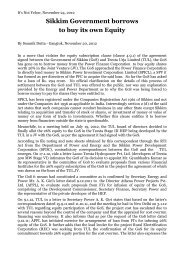Socio-Cultural Environment - Affected Citizens of Teesta (ACT)
Socio-Cultural Environment - Affected Citizens of Teesta (ACT)
Socio-Cultural Environment - Affected Citizens of Teesta (ACT)
Create successful ePaper yourself
Turn your PDF publications into a flip-book with our unique Google optimized e-Paper software.
8<br />
CISMHE<br />
The ethnic groups residing in the district are indo-mongoloids belonging<br />
to two dominant groups, namely the Lepchas and the Bhutias. A third<br />
group consisting <strong>of</strong> the people <strong>of</strong> Nepalese origin inhabiting the southern<br />
villages <strong>of</strong> the district includes a host <strong>of</strong> tribes and castes belonging to<br />
Indo-Aryan, Indo-Mongoloid and Proto-Australoid groups.<br />
The Lepchas are believed to be the earliest settlers <strong>of</strong> Sikkim. The<br />
origin <strong>of</strong> the Lepchas is somewhat obscure. According to the early<br />
anthropologists, the Lepchas migrated to Sikkim from the East, i.e. from<br />
the border regions <strong>of</strong> Tibet and Myanmar. The exact period <strong>of</strong> their entry<br />
in Sikkim could not be ascertained as the anthropologists and historians<br />
never established proven facts about their place <strong>of</strong> origin and reason <strong>of</strong><br />
migration. According to some the Lepchas belong to a Naga tribe while<br />
others have found likenesses with some tribes in Arunachal Pradesh.<br />
Still others contend that the Lepchas came from the west, i.e. from the<br />
Mech country in neighbouring Nepal. However, the Lepchas or the<br />
Rongs (the ravine folks), as they prefer to call themselves, are <strong>of</strong> firm<br />
belief that the land <strong>of</strong> Khangchendzonga is their own country and they<br />
know <strong>of</strong> no other country as their habitat. To quote a Lepcha writer, “On<br />
the slopes <strong>of</strong> these magnificent hills (Khangchendzonga) the Lepchas<br />
are born; there they live and there they die” (A.R. Foning, 1987). It is<br />
commonly agreed that the Lepchas are the most ancient inhabitants <strong>of</strong><br />
Sikkim and adjoining hills <strong>of</strong> Darjeeling, Kalimpong and Ilam in Nepal.<br />
The fact that most <strong>of</strong> the rivers, mountain tops, and places in the area<br />
have Lepcha names further substantiate the fact that the Lepchas had<br />
knowledge <strong>of</strong> all these landmarks much before the Bhutias or any other<br />
tribe reached this country.




